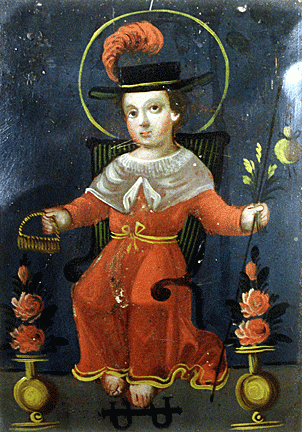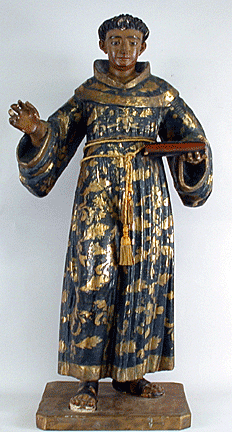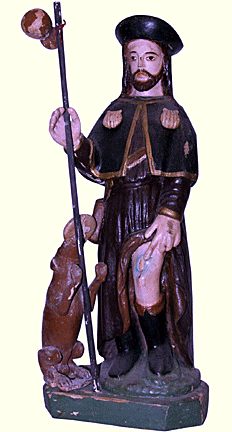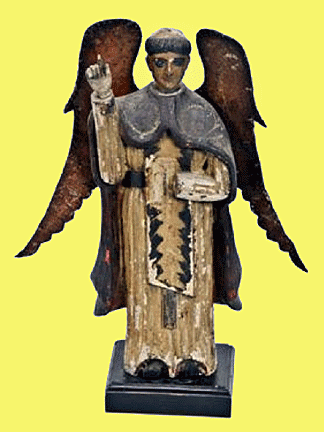 LATEST
ANTIQUES ARTICLE______________________________
A 400-Year-Old Tradition
by Bob Brooke
 Latinos,
especially those living in New Mexico, venerate wooden statues called
santos. These sculptures lie at the very heart of a 400-year-old
cultural tradition. They’ve existed for centuries, ever since the early
Spanish Colonial era. Latinos,
especially those living in New Mexico, venerate wooden statues called
santos. These sculptures lie at the very heart of a 400-year-old
cultural tradition. They’ve existed for centuries, ever since the early
Spanish Colonial era.
Santo literally means saint in Spanish. Besides taking the
three-dimensional form of wooden figures, called bultos, they can
also appear in the form of retablos, or paintings on wood panels.
A distinctive santo style developed in northern New Mexico and
southern Colorado in the 18th and 19th centuries. Using materials at
hand, such as pine and cottonwood, and creating pigments from natural
materials, santos makers, known as santeros, made objects
for use in religious observances as well as for home devotions. Some
santeros traveled from village to village, creating santos on
commission. People prayed to specific reasons according to their
individual powers, and also used them as intercessors, or go-betweens,
to God. For example, Santa Bárbara might be prayed to for protection
against fire while San Isidro Labrador might offer special protection
against drought or other problems facing farmers.
Santos in the New World
 Four
hundred years ago, the Spanish came to the New World and brought
significant changes. One of the most lasting changes was their faith,
Catholicism. The missionaries needed "visual aids" to help explain the
stories of the saints and the Passion of Christ to the native peoples
and used printed images from Spain. At first, they brought some statues
from Spain and Mexico. But eventually the making of santos fell
to Franciscan friars and then by local craftspersons and artists, many
of whom set up schools or escuelitas. Gradually santeros began to
carve and paint the popular saints to supply New Mexican churches and
homes. Four
hundred years ago, the Spanish came to the New World and brought
significant changes. One of the most lasting changes was their faith,
Catholicism. The missionaries needed "visual aids" to help explain the
stories of the saints and the Passion of Christ to the native peoples
and used printed images from Spain. At first, they brought some statues
from Spain and Mexico. But eventually the making of santos fell
to Franciscan friars and then by local craftspersons and artists, many
of whom set up schools or escuelitas. Gradually santeros began to
carve and paint the popular saints to supply New Mexican churches and
homes.
In the Americas, three main traditions of artisanship—Flemish, Italian,
and Spanish— contributed to a distinctly New World style, which blended
local expressions and native materials with older imported styles.
Generally, santos made for private devotion were smaller and not
as elaborate as santos commissioned for the Church. But either way, the
artisans who made them used the same materials and techniques regardless
of the sculpture’s purpose.
 Traditional
santo production began to decline in the 19th century as
mass-produced consumer goods, such as religious prints and painted
plaster saints, made their way into New Mexico by way of the Santa Fe
Trail and the Atchison,Topeka and Santa Fe Railroad. While a few
traditional santeros continued to work into the early 20th century, no
one passed on the tradition to younger people. At the same time, a group
of Anglo patrons in Santa Fe began collecting traditional santos as art
objects. They encouraged New Mexican Latinos to revive their cultural
traditions, primarily as a means to improve their economy through
production and sale of local arts and crafts. Traditional
santo production began to decline in the 19th century as
mass-produced consumer goods, such as religious prints and painted
plaster saints, made their way into New Mexico by way of the Santa Fe
Trail and the Atchison,Topeka and Santa Fe Railroad. While a few
traditional santeros continued to work into the early 20th century, no
one passed on the tradition to younger people. At the same time, a group
of Anglo patrons in Santa Fe began collecting traditional santos as art
objects. They encouraged New Mexican Latinos to revive their cultural
traditions, primarily as a means to improve their economy through
production and sale of local arts and crafts.
During the Great Depression, artists under the auspices of the Federal
Art Project of President Franklin Roosevelt’s New Deal, recorded and
reproduced traditional santos. As a result of this early 20th-century
“revival,” artists inaugurated the annual Spanish Market featuring the
work of contemporary santeros, held the last weekend of July in Santa
Fe.
The stories and images of the saints differed from those seen in Europe,
mostly because the indigenous peoples had limited contact with the
Church and spread the stories associated with the santos by word of
mouth, gradually changing some of the facts along the way. The isolation
of the New Mexico villages made visits by priests rare occurrences and
necessitated the use of lay clergy to keep the faith alive. Village
processions and celebrations centered around the treasured santos that
were on display in the church.
Noted Santeros
 Some
of the early Franciscan santeros include: "Franciscan F" a hide painter,
"Franciscan B", who may have been Francisco Xavier Romero of Mexico
City, Fray Andrés Garcia, and don Bernardo Miera y Pacheco, famous for
the Castrense altarscreen, now located at the Cristo Rey Church in Santa
Fe. Pedro Antonio Fresquis of Truchas, who lived from 1785 to 1831, was
the first native-born santero. The Laguna Santero, Antonio Molleno, the
Master of the Lattice-work Cross, and the Santero of the Mountain
Village Crucifixes, followed him.. Many of these early artists are only
known by their style, since they didn’t sign their works. Some
of the early Franciscan santeros include: "Franciscan F" a hide painter,
"Franciscan B", who may have been Francisco Xavier Romero of Mexico
City, Fray Andrés Garcia, and don Bernardo Miera y Pacheco, famous for
the Castrense altarscreen, now located at the Cristo Rey Church in Santa
Fe. Pedro Antonio Fresquis of Truchas, who lived from 1785 to 1831, was
the first native-born santero. The Laguna Santero, Antonio Molleno, the
Master of the Lattice-work Cross, and the Santero of the Mountain
Village Crucifixes, followed him.. Many of these early artists are only
known by their style, since they didn’t sign their works.
During the late 19th century, Juan Ramón Velásquez of Canjilón was one
of the first santeros to use housepaint, brought into the area after the
arrival of the railroad. José Benito Ortega of La Cueva, a prolific
santero, created bold images. José Inés Herrera, known as El Rito
Santero or the Death Cart Santero because of his large and threatening
images, worked in El Rito, New Mexico, from the late 19th century to the
early 20th.
Materials and Paints
 Santeros,
who had access to imported materials, used a range of woods including
Spanish cedar, Cuban mahogany, or Honduras mahogany, in addition to
local woods, including a variety of pines. Carvers preferred relatively
soft woods with fine texture and straight grain and also sought those
with durability and a resistance to insects. Santeros,
who had access to imported materials, used a range of woods including
Spanish cedar, Cuban mahogany, or Honduras mahogany, in addition to
local woods, including a variety of pines. Carvers preferred relatively
soft woods with fine texture and straight grain and also sought those
with durability and a resistance to insects.
Once a santero had carved a santo, he would paint it with either oil
paint or egg tempera–pigment mixed with egg yokes. Santeros worked in
the European tradition of polychrome, or painted wooden sculpture.
Typically, a santero carved and sanded a locally available wood to
achieve the contour and expression he wanted. Then he applied size,
usually animal glue, and gesso—chalk mixed with animal glue—or
gesso-soaked cloth to prepare the surface. He might have further sanded
the gesso to achieve a smoother surface for painting. Gesso provided an
ideal ground to receive paint. Without it, paint would sink
 into
the wood, yielding less color. Sometimes, an artist applied colored
bole, or fine clay mixed with glue, on top of gesso as a special
preparation for gold leaf. To decorate more elaborate polychromes, he
could also use gesso to build three-dimensional designs and then appled
paint or gold leaf. And, to create the illusion of richly embroidered
cloth, he could selectively scratch through the paint applied over gold
leaf. into
the wood, yielding less color. Sometimes, an artist applied colored
bole, or fine clay mixed with glue, on top of gesso as a special
preparation for gold leaf. To decorate more elaborate polychromes, he
could also use gesso to build three-dimensional designs and then appled
paint or gold leaf. And, to create the illusion of richly embroidered
cloth, he could selectively scratch through the paint applied over gold
leaf.
Generally, santeros used traditional colors. Ultramarine, a costly
pigment, was expensive and signified luxury. During the Middle Ages,
artists used it to paint the robes of the Virgin Mary, so santeros
carried on the tradition. Wealthy patrons frequently specified its use
in commissioned works. Other traditional pigments like lead white,
ground chalk, vermillion, and red lake can be seen on many santos.
During its lifetime, a santo may be repainted repeatedly during worship
and normal use.
<
More Special Features
|
